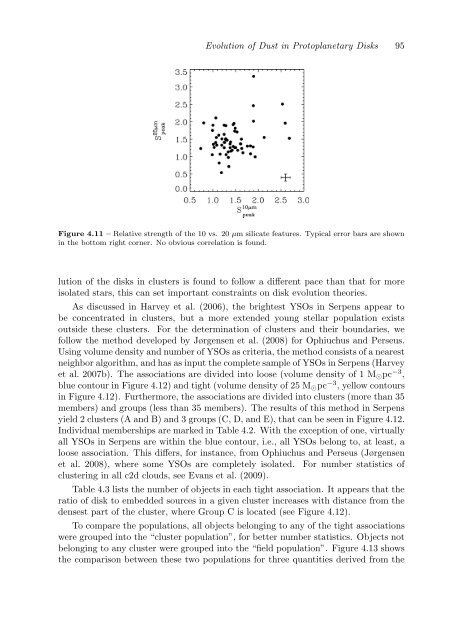Observational Constraints on The Evolution of Dust in ...
Observational Constraints on The Evolution of Dust in ...
Observational Constraints on The Evolution of Dust in ...
Create successful ePaper yourself
Turn your PDF publications into a flip-book with our unique Google optimized e-Paper software.
Evoluti<strong>on</strong> <strong>of</strong> <strong>Dust</strong> <strong>in</strong> Protoplanetary Disks 95<br />
Figure 4.11 – Relative strength <strong>of</strong> the 10 vs. 20 µm silicate features. Typical error bars are shown<br />
<strong>in</strong> the bottom right corner. No obvious correlati<strong>on</strong> is found.<br />
luti<strong>on</strong> <strong>of</strong> the disks <strong>in</strong> clusters is found to follow a different pace than that for more<br />
isolated stars, this can set important c<strong>on</strong>stra<strong>in</strong>ts <strong>on</strong> disk evoluti<strong>on</strong> theories.<br />
As discussed <strong>in</strong> Harvey et al. (2006), the brightest YSOs <strong>in</strong> Serpens appear to<br />
be c<strong>on</strong>centrated <strong>in</strong> clusters, but a more extended young stellar populati<strong>on</strong> exists<br />
outside these clusters. For the determ<strong>in</strong>ati<strong>on</strong> <strong>of</strong> clusters and their boundaries, we<br />
follow the method developed by Jørgensen et al. (2008) for Ophiuchus and Perseus.<br />
Us<strong>in</strong>g volume density and number <strong>of</strong> YSOs as criteria, the method c<strong>on</strong>sists <strong>of</strong> a nearest<br />
neighbor algorithm, and has as <strong>in</strong>put the complete sample <strong>of</strong> YSOs <strong>in</strong> Serpens (Harvey<br />
et al. 2007b). <strong>The</strong> associati<strong>on</strong>s are divided <strong>in</strong>to loose (volume density <strong>of</strong> 1 M ⊙ pc −3 ,<br />
blue c<strong>on</strong>tour <strong>in</strong> Figure 4.12) and tight (volume density <strong>of</strong> 25 M ⊙ pc −3 , yellow c<strong>on</strong>tours<br />
<strong>in</strong> Figure 4.12). Furthermore, the associati<strong>on</strong>s are divided <strong>in</strong>to clusters (more than 35<br />
members) and groups (less than 35 members). <strong>The</strong> results <strong>of</strong> this method <strong>in</strong> Serpens<br />
yield 2 clusters (A and B) and 3 groups (C, D, and E), that can be seen <strong>in</strong> Figure 4.12.<br />
Individual memberships are marked <strong>in</strong> Table 4.2. With the excepti<strong>on</strong> <strong>of</strong> <strong>on</strong>e, virtually<br />
all YSOs <strong>in</strong> Serpens are with<strong>in</strong> the blue c<strong>on</strong>tour, i.e., all YSOs bel<strong>on</strong>g to, at least, a<br />
loose associati<strong>on</strong>. This differs, for <strong>in</strong>stance, from Ophiuchus and Perseus (Jørgensen<br />
et al. 2008), where some YSOs are completely isolated. For number statistics <strong>of</strong><br />
cluster<strong>in</strong>g <strong>in</strong> all c2d clouds, see Evans et al. (2009).<br />
Table 4.3 lists the number <strong>of</strong> objects <strong>in</strong> each tight associati<strong>on</strong>. It appears that the<br />
ratio <strong>of</strong> disk to embedded sources <strong>in</strong> a given cluster <strong>in</strong>creases with distance from the<br />
densest part <strong>of</strong> the cluster, where Group C is located (see Figure 4.12).<br />
To compare the populati<strong>on</strong>s, all objects bel<strong>on</strong>g<strong>in</strong>g to any <strong>of</strong> the tight associati<strong>on</strong>s<br />
were grouped <strong>in</strong>to the “cluster populati<strong>on</strong>”, for better number statistics. Objects not<br />
bel<strong>on</strong>g<strong>in</strong>g to any cluster were grouped <strong>in</strong>to the “field populati<strong>on</strong>”. Figure 4.13 shows<br />
the comparis<strong>on</strong> between these two populati<strong>on</strong>s for three quantities derived from the
















